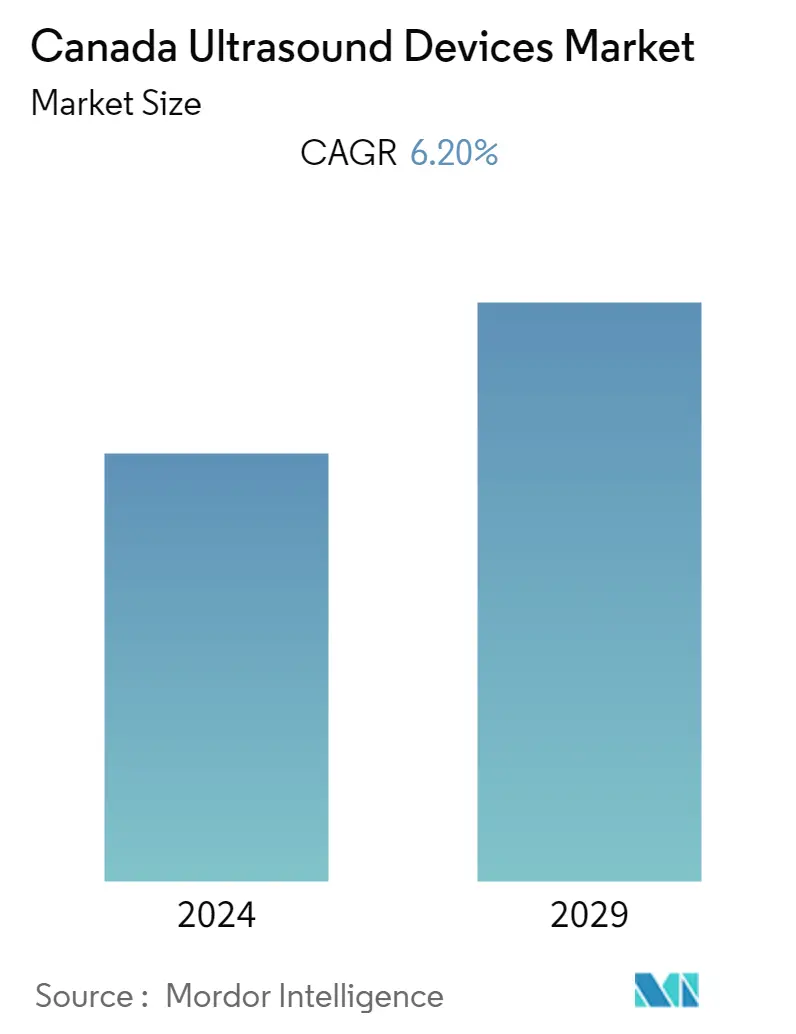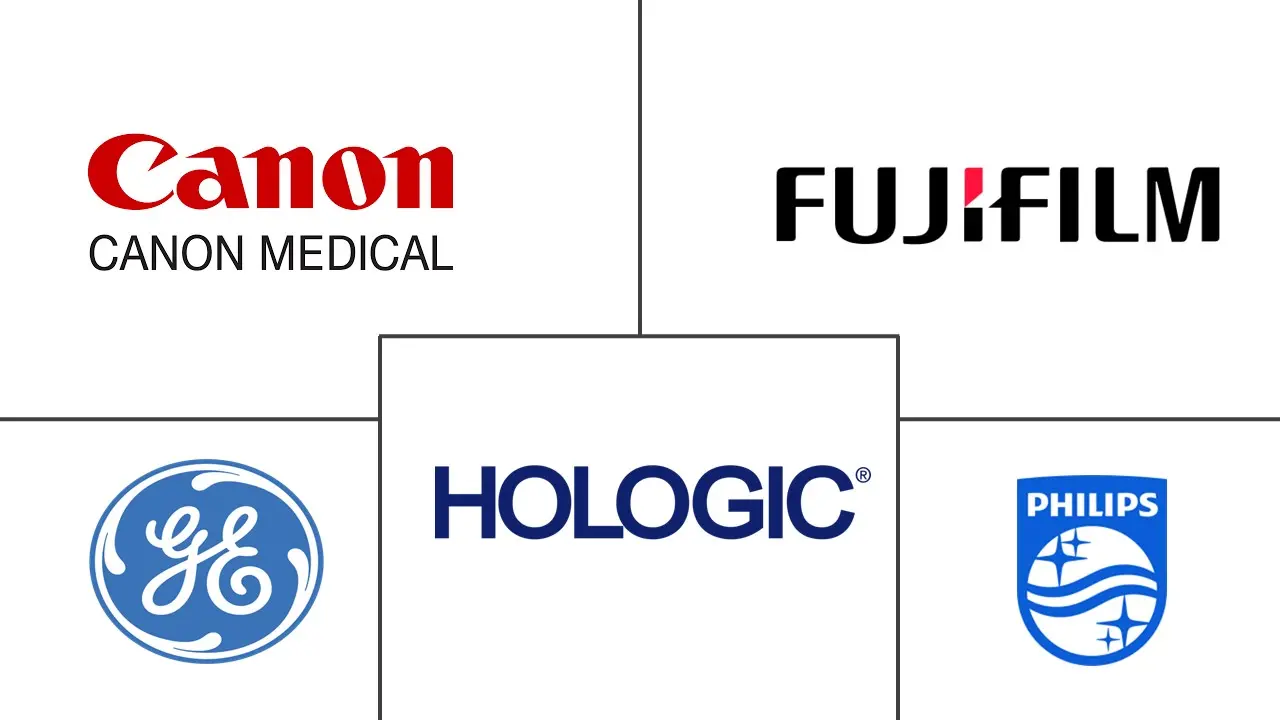Market Size of Canada Ultrasound Devices Industry

| Study Period | 2019 - 2029 |
| Base Year For Estimation | 2023 |
| Forecast Data Period | 2024 - 2029 |
| Historical Data Period | 2019 - 2022 |
| CAGR | 6.20 % |
| Market Concentration | Medium |
Major Players
*Disclaimer: Major Players sorted in no particular order |
Ultrasound Devices Market Analysis
The Canada Ultrasound Devices Market size is expected to grow from USD 386.33 million in 2023 to USD 521.89 million by 2028, at a CAGR of 6.20% during the forecast period.
COVID-19 had an adverse impact on the ultrasound device market in Canada due to the COVID-19 restriction and closed non-urgent hospital services. Moreover, ultrasound was a vital device to use for the COVID-19 diagnosis. For instance, according to the study published in the Canadian Journal of Anaesthesia in August 2021, point-of-care ultrasound (POCUS) was helpful for bedside evaluation of COVID-19 patients' lung conditions, and its use of ultrasound was increased in emergency medicine anesthesiology followed by critical care, and family medicine during the COVID-19 pandemic. Thus, during COVID-19, the use of ultrasound was raised to diagnose COVID-19. However, the market is currently growing at a stable pace owing to a resumption of diagnostic procedures and a decline in COVID-19 cases, and it is expected to witness a similar trend over the coming years.
The factors driving the market growth include the growing burden of chronic diseases such as cancer, cardiovascular, neurological disorders, abdominal diseases, and others, coupled with technological advancement and the rising number of healthcare providers, further, according to the data published by the Kidney Foundation Canada in January 2022, one in every ten Canadians suffers from renal disease, 4 million people each year. A kidney ultrasound assesses the kidneys' size, location, shape, and related structures, such as the ureters and bladder. Ultrasound can detect cysts, tumors, abscesses, obstructions, fluid collection, and infection within or around the kidneys. Thus, the high burden of kidney diseases in the Canadian population is expected to boost the demand for better imaging diagnoses like ultrasound, contributing to market growth.
Moreover, with the new technological innovations and developments, the launch of unique products by key companies in the country is expected to increase access to these devices, thereby boosting market growth. For instance, in June 2021, Butterfly Network, Inc. reported that its second-generation iQ+ had been approved for a Class III Medical Device License in Canada. The iQ+ features Ultrasound-on-Chip technology, with several hardware and software advances designed to improve usability and care delivery. Similarly, in November 2021, PENTAX Medical reported the Canadian launch of their new Performance Endoscopic Ultrasound (EUS) system, a combination of the new Arietta 65 PX ultrasound scanner and their best-in-class J10 Series ultrasound gastroscopes.
Hence, the growing burden of chronic kidney diseases and product launches by the market players is expected to boost market growth over the forecast period. However, strict regulation and a lack of skilled labor to handle the advanced equipment may restrain the market's growth over the next period.
.
Ultrasound Devices Industry Segmentation
As per the scope of the report, a diagnostic ultrasound, also known as sonography, is an imaging technique that uses high-frequency sound waves to produce images of the different structures inside the body. They are being utilized to assess various conditions in the kidney, liver, and other abdominal disorders. They are also majorly used in chronic diseases, including heart disease, asthma, cancer, and diabetes. Canada Ultrasound Devices Market is Segmented by Application (Anesthesiology, Cardiology, Gynecology/Obstetrics, Musculoskeletal, Radiology, Critical Care, and Other Applications), Technology (2D Ultrasound Imaging, 3D and 4D Ultrasound Imaging, Doppler Imaging, and High-intensity Focused Ultrasound), Type (Stationary Ultrasound and Portable Ultrasound). The report offers the value (in USD million) for the above segments.
| By Application | |
| Anesthesiology | |
| Cardiology | |
| Gynecology/Obstetrics | |
| Musculoskeletal | |
| Radiology | |
| Critical Care | |
| Other Applications |
| By Technology | |
| 2D Ultrasound Imaging | |
| 3D and 4D Ultrasound Imaging | |
| Doppler Imaging | |
| High-intensity Focused Ultrasound |
| By Type | |
| Stationary Ultrasound | |
| Portable Ultrasound |
Canada Ultrasound Devices Market Size Summary
The Canada ultrasound devices market is poised for significant growth, driven by the increasing prevalence of chronic diseases such as cancer, cardiovascular, and renal disorders. The market's expansion is further supported by technological advancements and the rising number of healthcare providers. The demand for ultrasound devices is particularly bolstered by the high burden of kidney diseases, necessitating better imaging diagnostics. The market experienced a temporary setback due to COVID-19, which initially restricted non-urgent hospital services. However, the pandemic also highlighted the importance of ultrasound in diagnosing COVID-19, leading to an increased adoption of point-of-care ultrasound in various medical fields. As diagnostic procedures resume and COVID-19 cases decline, the market is expected to grow steadily.
The market is characterized by strategic initiatives from key players, including product launches and partnerships, which are enhancing the accessibility and capabilities of ultrasound devices. Innovations such as Butterfly Network's Ultrasound-on-Chip technology and PENTAX Medical's new endoscopic ultrasound system exemplify the advancements driving market growth. The presence of major companies like GE Healthcare, Fujifilm Holdings Corporation, and Canon Medical Systems underscores the competitive landscape. Additionally, the development of AI-powered ultrasound technologies and collaborations for advanced imaging solutions are expected to further propel the market. Despite challenges like strict regulations and a shortage of skilled labor, the market's growth trajectory remains positive, supported by the ongoing demand for early diagnosis and treatment of diseases.
Canada Ultrasound Devices Market Size - Table of Contents
-
1. MARKET DYNAMICS
-
1.1 Market Overview
-
1.2 Market Drivers
-
1.2.1 Technological Advancements and Increasing Number of Healthcare Providers
-
1.2.2 Increasing Incidences of Chronic Diseases
-
-
1.3 Market Restraints
-
1.3.1 Strict Regulations
-
1.3.2 Lack of Skilled Labor to Handle the Advanced Equipment
-
-
1.4 Porter's Five Forces Analysis
-
1.4.1 Threat of New Entrants
-
1.4.2 Bargaining Power of Buyers/Consumers
-
1.4.3 Bargaining Power of Suppliers
-
1.4.4 Threat of Substitute Products
-
1.4.5 Intensity of Competitive Rivalry
-
-
-
2. MARKET SEGMENTATION (Market Size by Value - USD million)
-
2.1 By Application
-
2.1.1 Anesthesiology
-
2.1.2 Cardiology
-
2.1.3 Gynecology/Obstetrics
-
2.1.4 Musculoskeletal
-
2.1.5 Radiology
-
2.1.6 Critical Care
-
2.1.7 Other Applications
-
-
2.2 By Technology
-
2.2.1 2D Ultrasound Imaging
-
2.2.2 3D and 4D Ultrasound Imaging
-
2.2.3 Doppler Imaging
-
2.2.4 High-intensity Focused Ultrasound
-
-
2.3 By Type
-
2.3.1 Stationary Ultrasound
-
2.3.2 Portable Ultrasound
-
-
Canada Ultrasound Devices Market Size FAQs
What is the current Canada Ultrasound Devices Market size?
The Canada Ultrasound Devices Market is projected to register a CAGR of 6.20% during the forecast period (2024-2029)
Who are the key players in Canada Ultrasound Devices Market?
GE Healthcare, Fujifilm Holdings Corporation, Canon Medical Systems, Koninklijke Philips N.V. and Hologic Inc. are the major companies operating in the Canada Ultrasound Devices Market.

